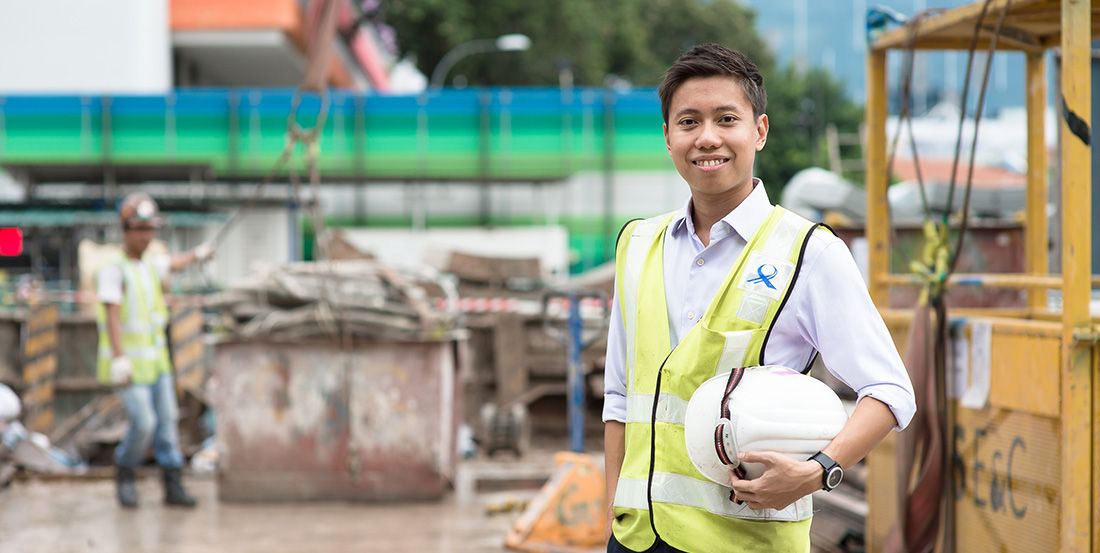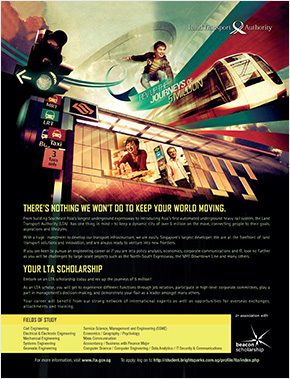Singapore is dotted with Mass Rapid Transit (MRT) stations that connect one vibrant community to another. Home to an intricate network of railway lines, the country is an easy place for city-dwellers to travel from end to end safely and comfortably.
The Land Transport Authority (LTA) is at the centre of our country’s first-rate and reliable transport system. It champions the development and regulation plans of the Ministry of Transport and positions itself as a key player in our daily transportation activities. In the excellent execution of its construction, maintenance and development projects, LTA is committed to connecting people to places – one station at a time.
Executive Project Engineer Alexander Ng is part of the LTA team that works to enhance our advanced transport system. He plays an important role in managing the construction efforts of underground MRT stations in the Downtown Line, and is currently involved in the tunneling works of the Fort Canning Station after having previously coordinated the construction efforts of the Bencoolen Station.
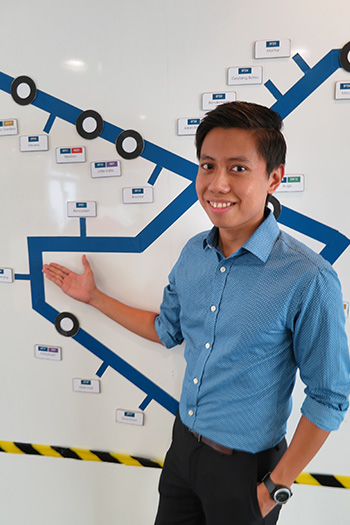
Alexander Ng Li De
LTA Undergraduate Scholar
Designation: Executive Project Engineer,
Rail Projects
Studied: Bachelor of Civil Engineering,
University of Illinois at Urbana-Champagne, US
He tells us, “I’ve had the chance to witness both the construction of a station via the top-down construction method and the construction of a tunnel which involves excavating the tunnel’s surrounding soil. My exposure has expanded my engineering skillsets and abilities and has also helped me better understand the entire transportation system.”
Building Infrastructure, Building Relationships
In witnessing the construction processes of both MRT stations, Alexander has proven his mettle not only in handling complex engineering issues, but also in honing his skills in building good stakeholder relationships. A weighty portion of his work sees him working closely with contractors and consultants to ensure that work progresses on schedule. Alexander tells us that this requires considerable finesse because each stakeholder has an interest to protect and reaching a common agreement among all involved parties does not come easy.
He details, “Contractors are concerned with adopting the most cost-effective measures and designers on the other hand would insist on employing the most conservative designs. We have to find a way to balance the concerns of all parties and conduct a cost-benefit analysis to see how best to execute our project, without compromising on its safety standards and quality.”
Alexander is often required to view his projects from the perspectives of multiple stakeholders. He explains that a section of Bencoolen Street had to be closed to accommodate the construction works of the Bencoolen MRT Station below it, and many surrounding hotels and schools were affected during the construction process, which also involved fitting machinery and excavation materials between the walls of a dense rail corridor.
He elaborates, “Many stakeholders were concerned about their reduced land area and the overall noise accumulation. We had to work to seek their understanding and stagger our working hours as much as possible. In fact, our 24-hour daily operating schedule had to be reduced to a 10-hour one to accede to the requests of hotels nearby. The process of reaching a mutual understanding has taught us to be empathetic and has certainly honed our ‘people’ skills.”
Preparing Him for Today
Alexander shares that the most challenging part of building the Downtown Line was the year-long process of diverting the Singapore River. He tells us that the unusual construction process involved demolishing parts of the old river embankment and mitigating risks associated with the close proximity of the river canal to the Central Expressway (CTE) tunnel. “Right now, I am working with contractors to reinstate the river back to its original position,” he tells us with a smile.
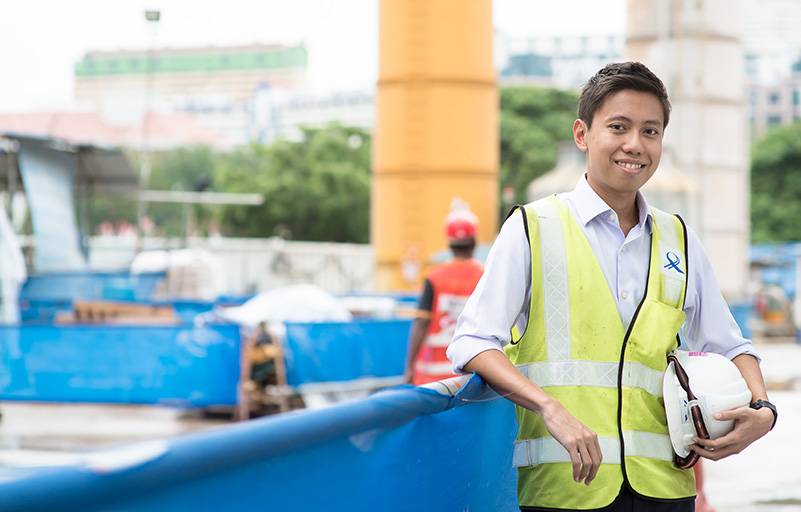
Alexander is able to excel in his work today because he has had plenty of early opportunities to be in tune with the technical aspects of his work. These opportunities have allowed him to develop his analytical and problem-solving skills, and have put him in a better position to tackle his challenges today.
For instance, while he was pursuing his Bachelor of Civil Engineering at the University of Illinois at Urbana-Champaign, US, Alexander had the chance to participate in a rail engineering and transportation programme at the Rail Transportation and Engineering Centre (RailTEC), a research centre based in the Civil and Environmental Engineering department of his university. He details, “RailTEC conducts engineering studies on behalf of the US government and I was part of the group analysing the economic viability, engineering perspective and overall feasibility of the high-speed rail system. It was a fun and interesting experience to have been involved in this extensive US study.”
In fact, Alexander also gained a more in-depth understanding of rail projects when he participated in his exchange programme at the National Taiwan University, Taiwan. He enthuses, “The US is always in contact with professors at the university who have plenty of research experience in Taiwan’s high-speed rail line. We went over to see how they managed to develop a complex system, learn from them and better understand their construction processes. My overseas experiences exposed me to new cultures and perspectives, and allowed me to participate in plenty of idea-bouncing. I am now in a better position to see if another country’s engineering practices can be brought over to Singapore.”
His LTA scholarship also gave him the chance to be exposed to LTA’s work early on through his internship at the Transportation and Road Operations Group. In working alongside LTA and the Singapore Youth Olympic Games (YOG) Organising Committee, Alexander had a hand in facilitating the timely arrival of athletes and officials at competition venues during the inaugural YOG. He adds, “I remember sitting on buses to measure the time it took us to get from one venue to another! We also had to be forward-looking and plan alternative routes for buses to take in the event of unfavourable traffic conditions along the CTE or the Pan Island Expressway (PIE).”
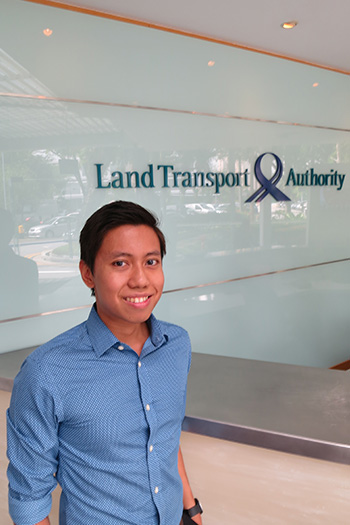
The Bigger Picture
Much like putting pieces together to form a complete jigsaw puzzle, the sustainable growth of Singapore’s transport system requires the collaborative efforts of various agencies. Alexander details, “For an LTA project to be implemented, we need to work with NParks who are concerned with protecting the trees and the environment, with PUB who seeks to mitigate drainage or river realignment problems and with URA who assesses the condition of our allotted land parcels.”
Similarly, Alexander tells us that the stellar work of LTA is not possible without the contributions of various divisions within the organisation. He tells us, “Given its diversified operations, LTA has something for everyone – be it in the finance, business, policy-making, project, design or engineering departments. It is important to acquire the thirst for knowledge and take a keen interest in learning from everyone you meet.
“It really is the intangible parts of my work that I find most fulfilling. We used to be able to connect people to their friends and families in half an hour, but it is heartening to know that we are able to do so in 10 minutes now. This sense of satisfaction cannot be quantified and I certainly appreciate this softer side of engineering.”
